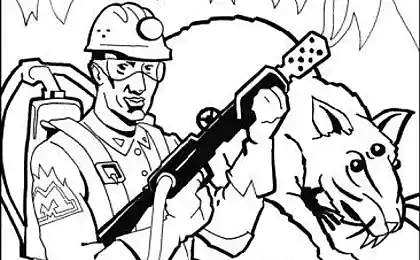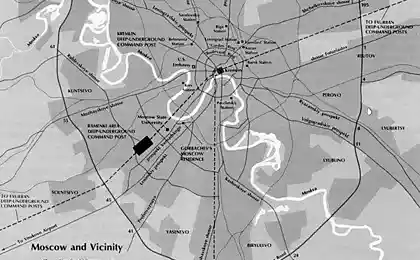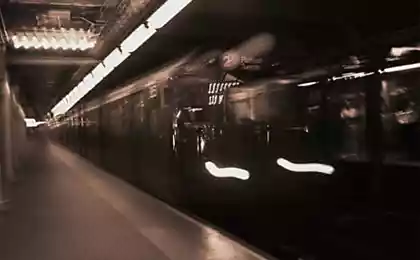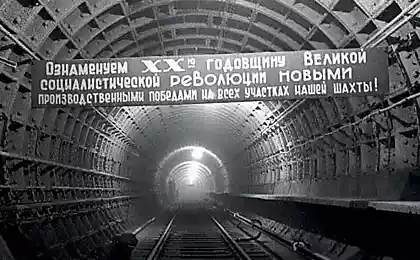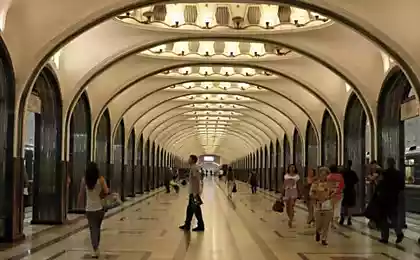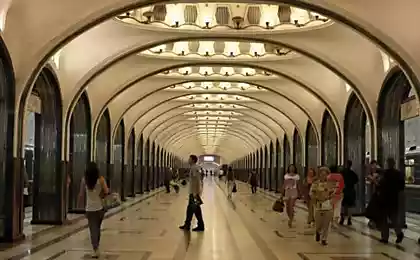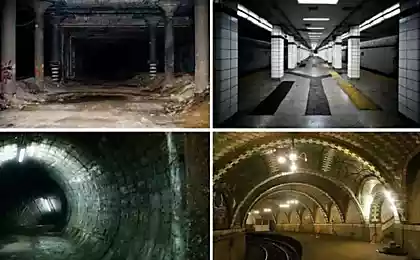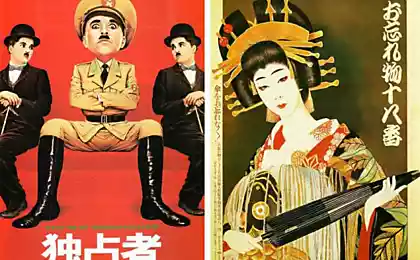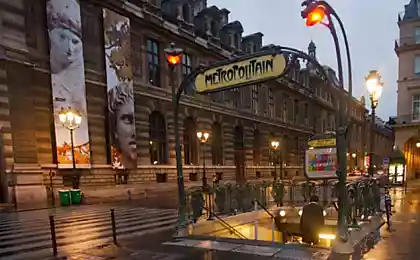820
As the first phase of the Moscow metro
Writes blogger russos:
A few years ago I came upon a bundle of old photographs from the newspaper "Metrostroevets." They were scanned and permanently buried on your hard drive. Now I'll show them to you. A dozen photographs signed on the back side. More on some you can guess what the object is in them or what people are doing metrostroevtsy. And some impossible to determine where the bottom, and where the top. But to each, I will try to give at least some comment.
To the question "Where was it taken?" You can answer clearly signed photo, a place where indicated.
Mine №18. (Station "Chistye Prudy", then - "Kirov»)
Tankelevich AG, Head of mine № 18-18-bis underground, at a depth of 40 meters, in the most difficult geological conditions should have been during the year to build a huge trehsvodchaty palace with large rooms, spacious lobby, wide corridors. For this construction had to apply new, hitherto unknown methods to go to master the unfamiliar equipment. We had to do a great job of digging, put tens of thousands of cubic meters of concrete. It was an honorable task and solve it was very interesting. The work was a lot.
74 photos
1. Flooded barrel. I can assume that it is mine №20 (- Comrades ... twentieth flooded mine ... no energy, pumps do not work. The water was coming fast. I walked 20 precast metal tongue, and the water went over it with great speed and force. Here), but in fact, we see flooded with outgoing trunk down the stairs.

Mine №20. (stage "Pure ponds" - "Red Gate") Noteworthy is the fact that has been passed by artificial freezing. It was a dress rehearsal before the sinking of the oblique stroke from freezing.
PP Rotert, head Metrostroi: Different methods of penetration of the inclined shafts. They could pass via compressed air. However, given that they are under the streets with more traffic, partly under the houses, we thought that the performance of work under compressed air in such circumstances required to have a full guarantee that there will be any interruption in the supply of electricity, as in this the case could be a major accident occur. Not wanting to go to risk, we decided to apply for the job method of freezing using directional wells. This method has previously been tested in the mine number 20, which we were specifically in such a way so as to prepare for the implementation of a more serious problem of sinking the inclined shafts.
2. Caisson devices. In the background is a building with a sign: "Barber №3. * - * Trust Sokolniki district. "

3. Ibid. In the foreground you can guess the shaft collar.
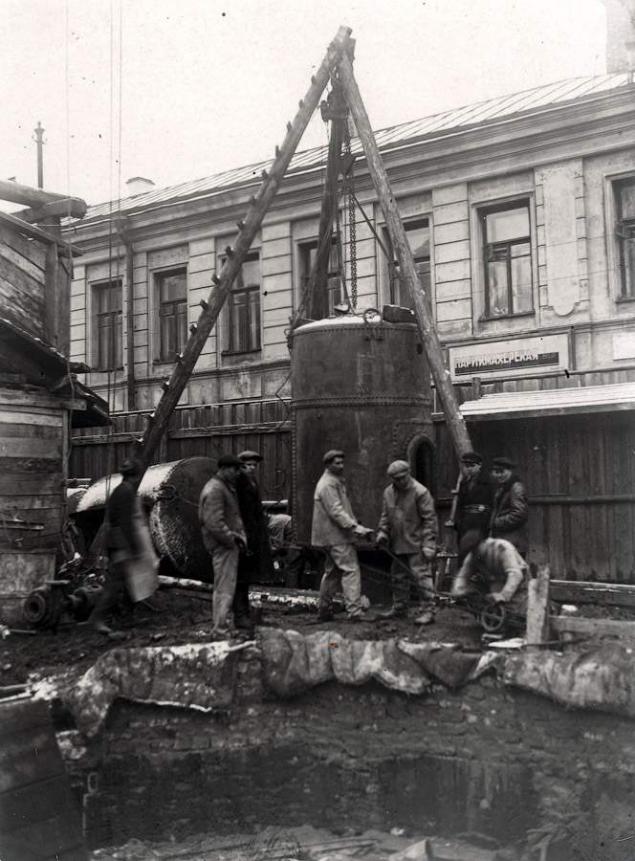
4. Yeah, it's mine. Workers are busy with a coffered device.
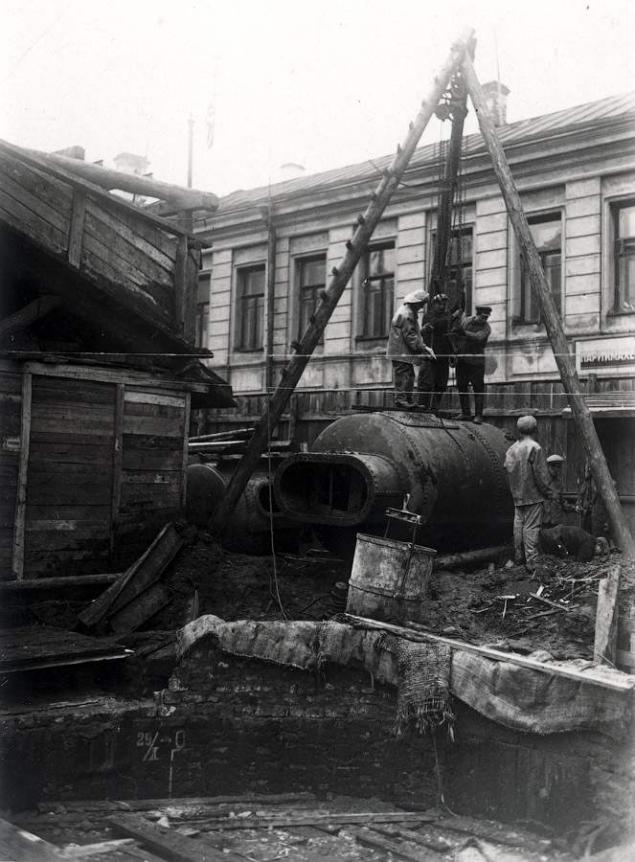
5. According to the couple, and a metal dowel, this Koper for its blockage.

6.
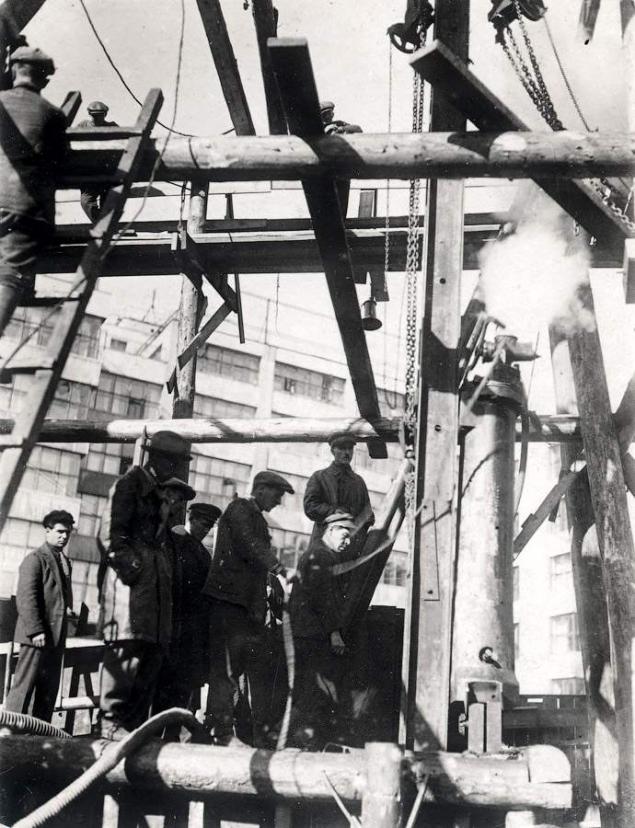
7.
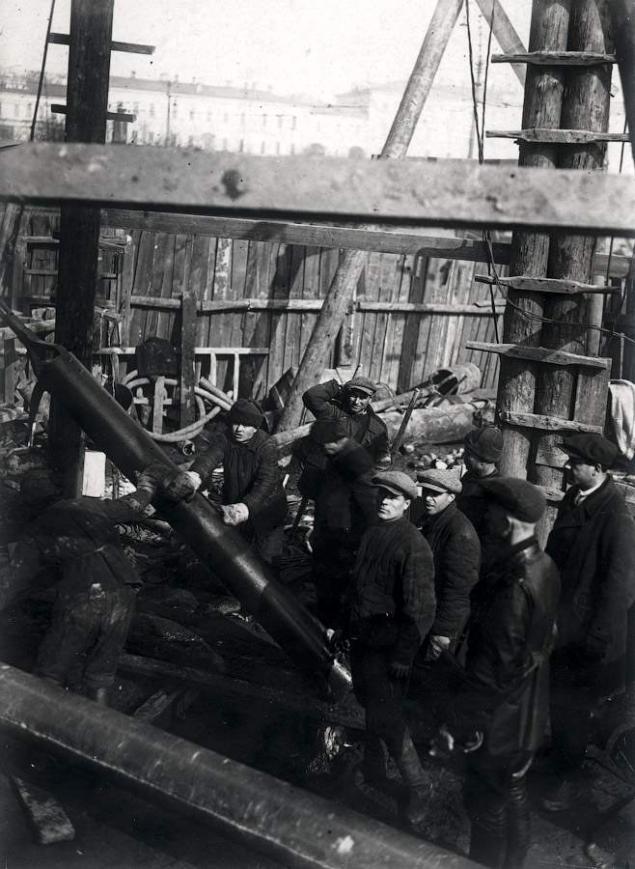
8. Fossil.
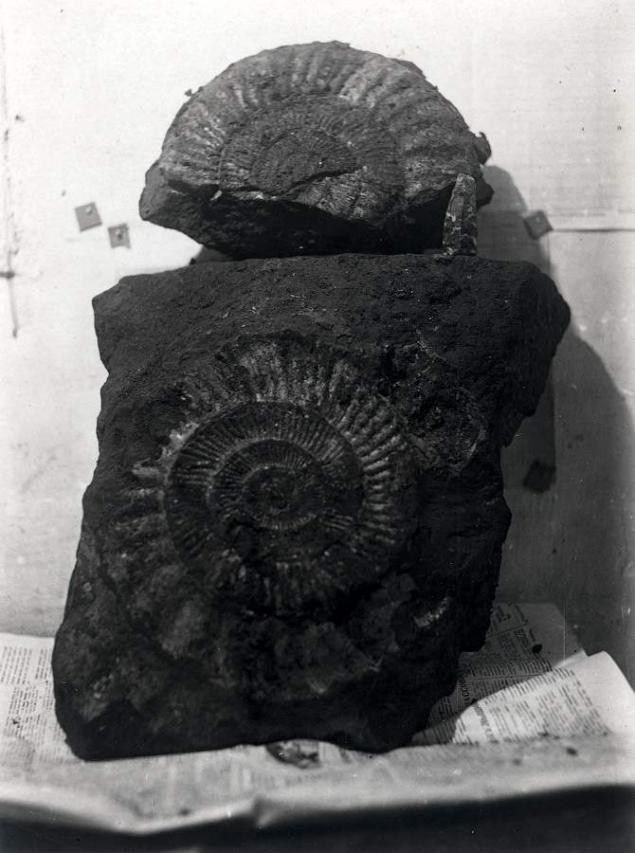
9. What kind of exercise in the trunk. By today's standards of TB, of course, breath-taking - the workers lacked even a helmet. But for those times it was considered perfectly acceptable.
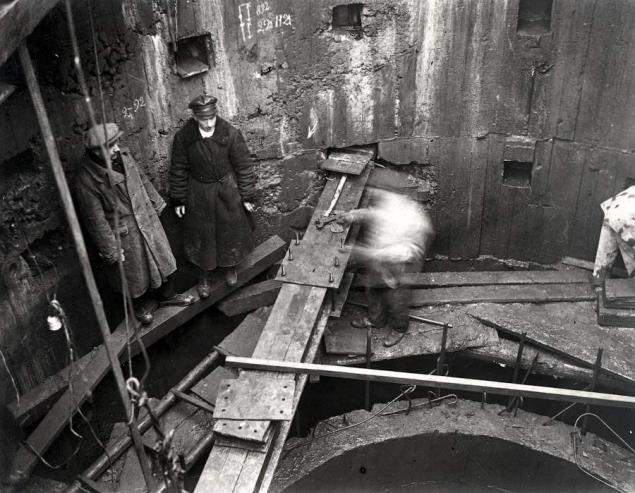
10. It seems, once again clogging the tongue. I recall that shaft sinking technology existed then a lot. Including, and avoiding the contour of the tongue, and dredging.
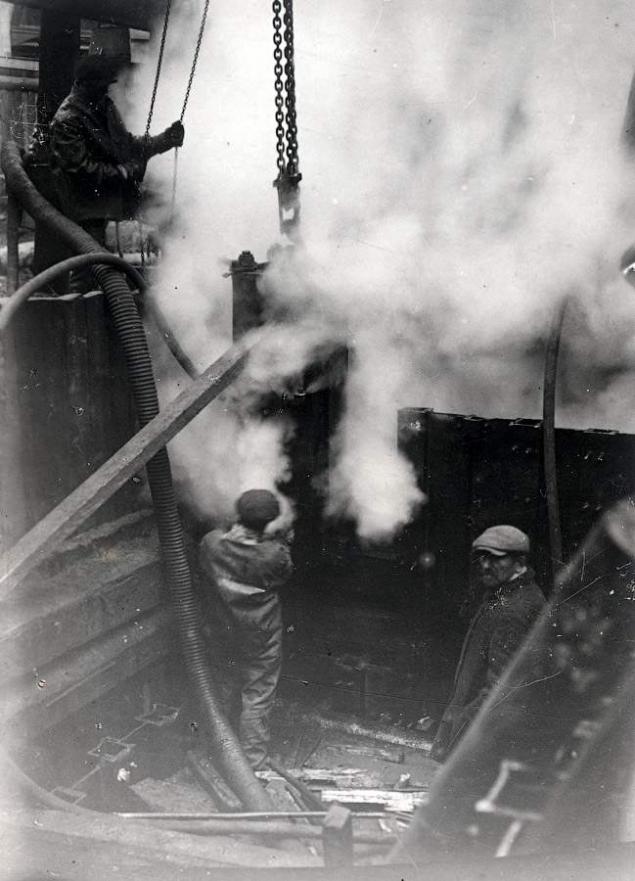
11. The trolley stands in the top of the pile driver. In the street, according to the icicles, cold.
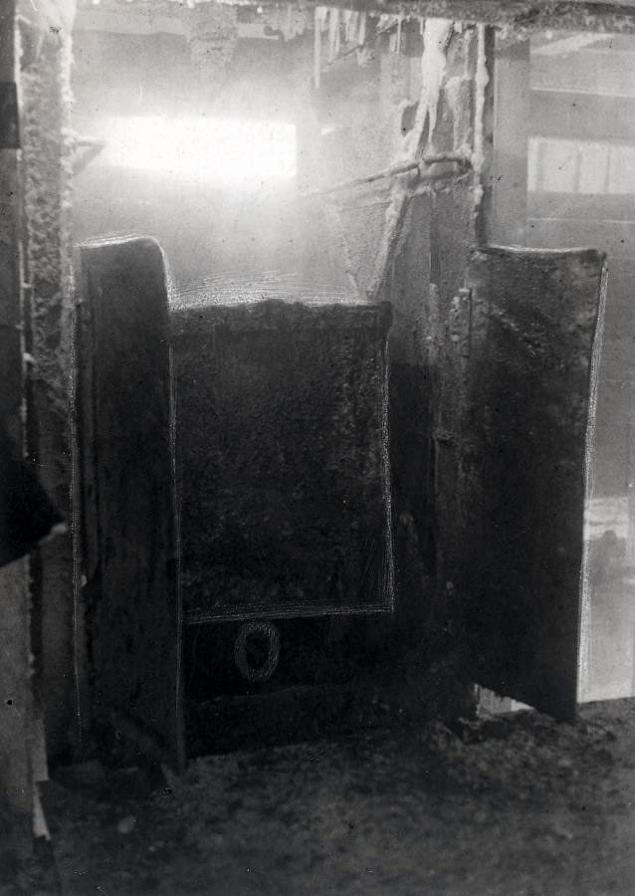
12.
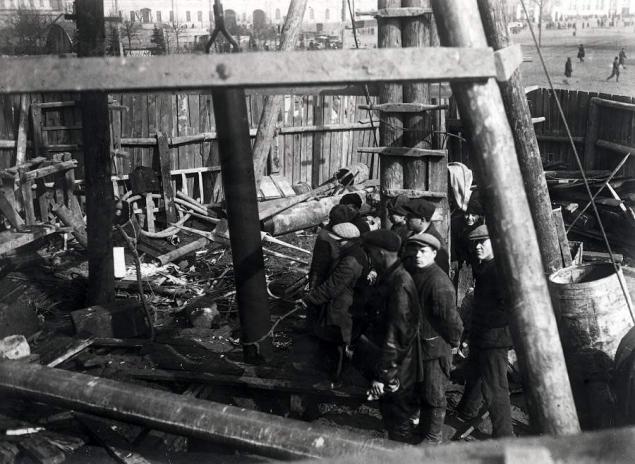
13.

14. In the bottom galleries.
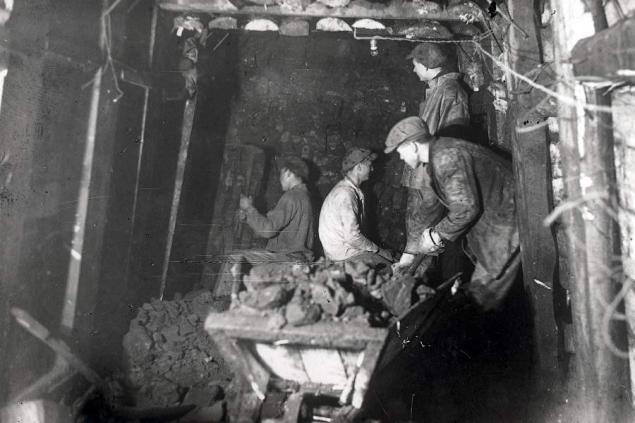
15. Adit.
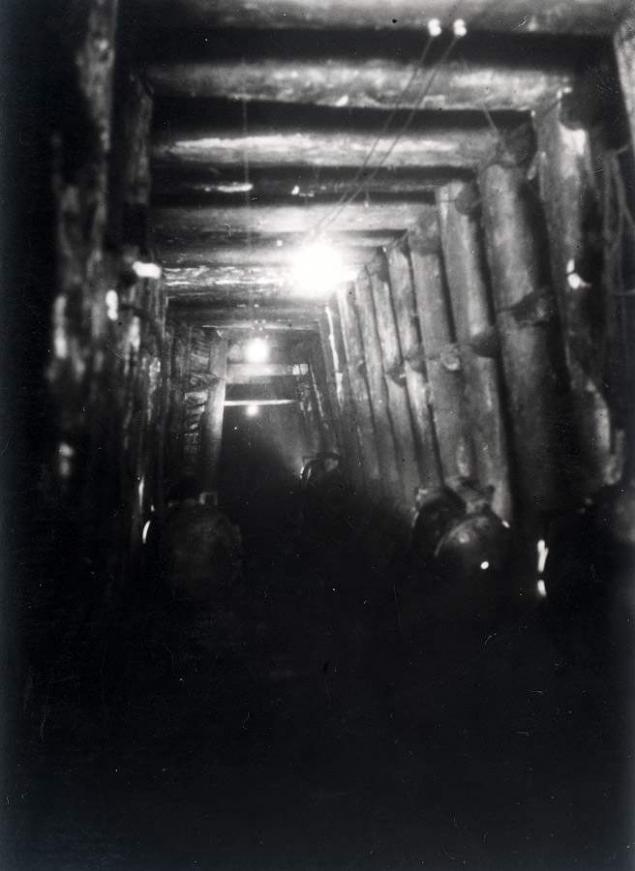
16. By kruzhalam in the foreground, is a preparation for concreting Calotte.
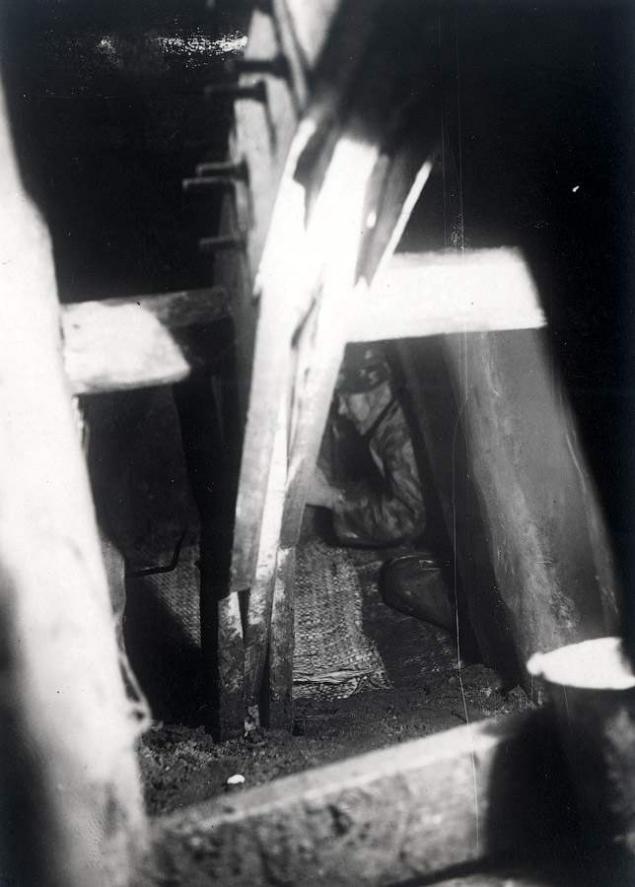
17.
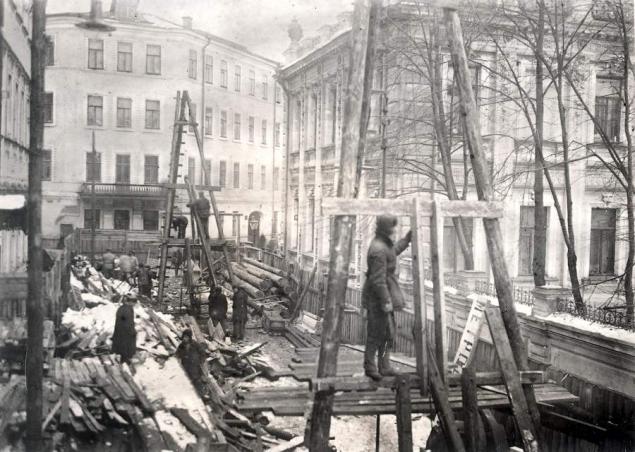
18.

19. Details of the caisson.

20.

21. Old photoshop. Apparently, for the layout of the installation.
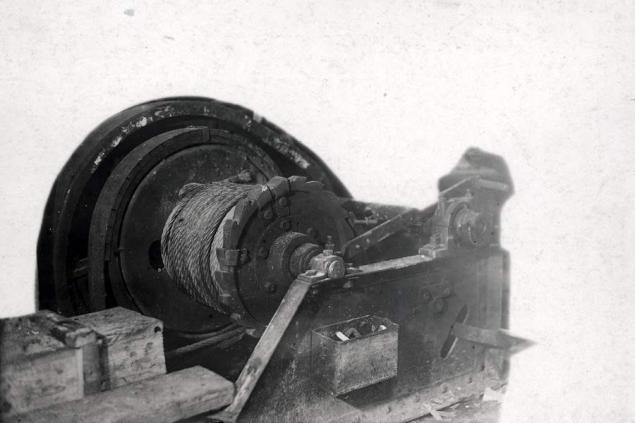
22. From a photo cut out right, superimposed on the white paper and make a copy again.

23. Caisson apparatus installed in the shaft.
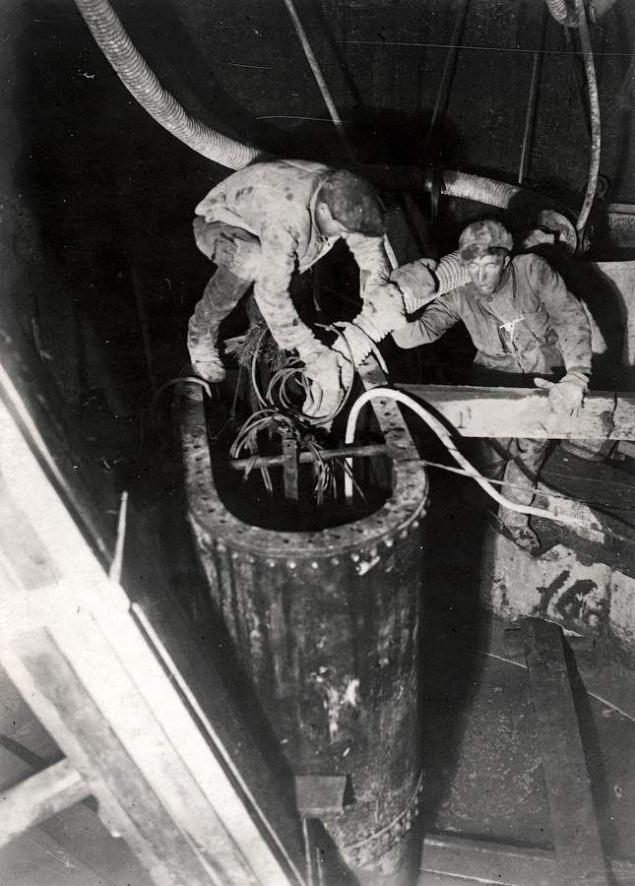
24. Another fossil.
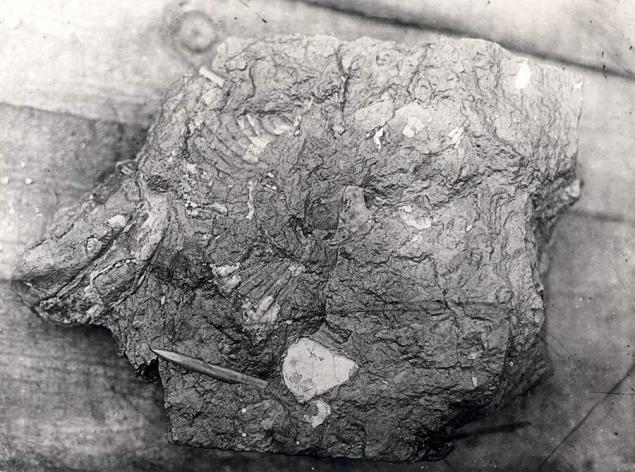
25. In the trunk. On the left - a large tank (most likely, compressed air), right - some pump. Maybe drainage.
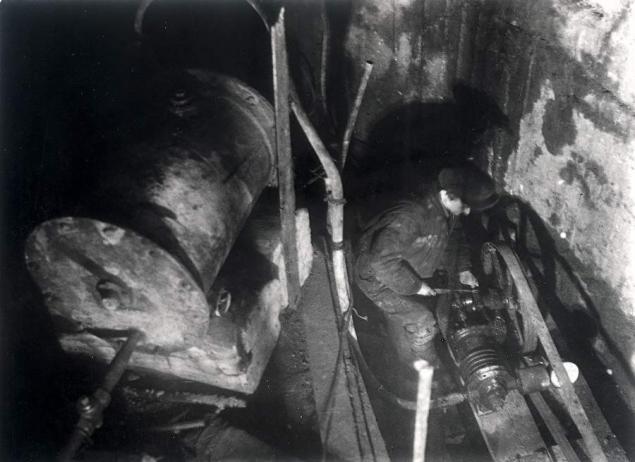
26. Compressor. American. It says: «CHICAGO PNEUMATIC TOOL»
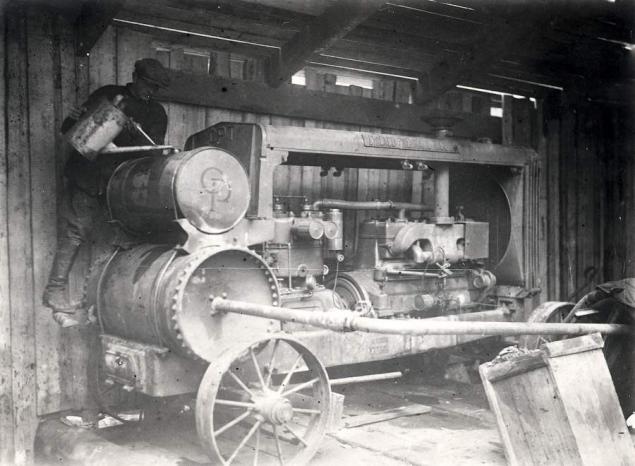
27. Lock vault. What is most interesting, it is made of stone instead of monolithic concrete.
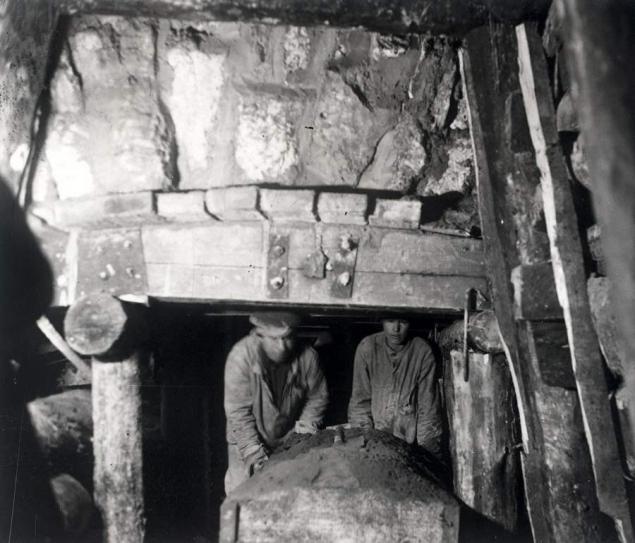
28. The jack with the log.

29. Take out the breed?
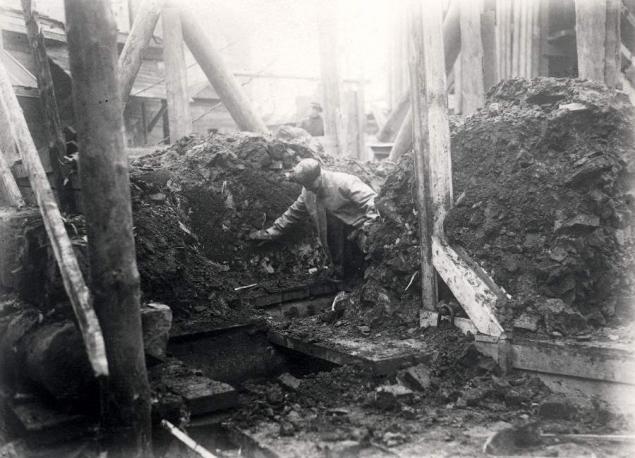
30. It is not clear where is the upper hand, and what is this design. Some wedges are hammered into the metal tube.
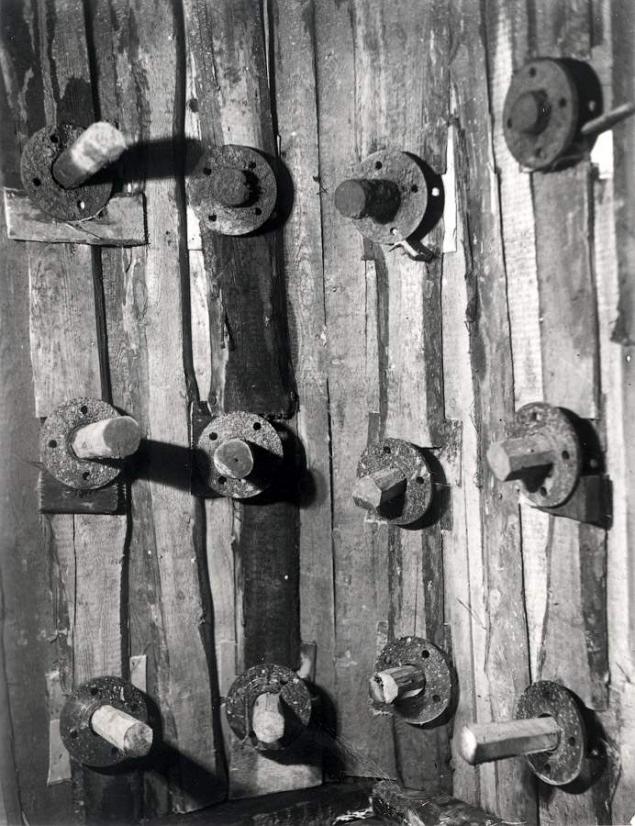
31.
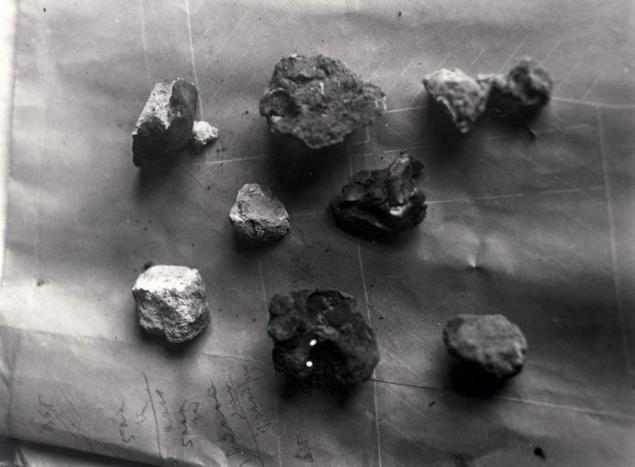
32. It seems that this is disclosed Calotte but not yet concreted.
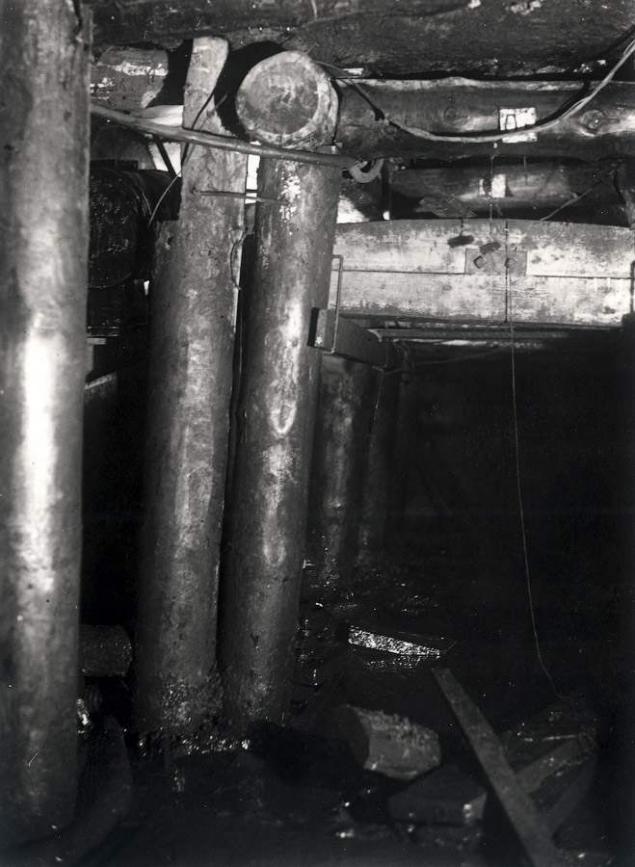
33. Radiator?
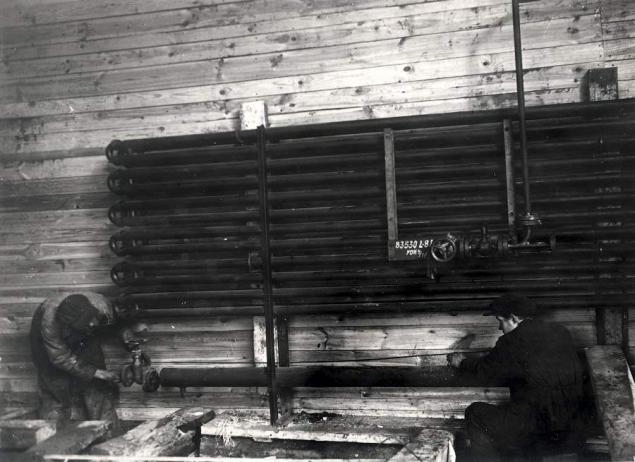
34. Mine Street. Well, experts, identifies the street?
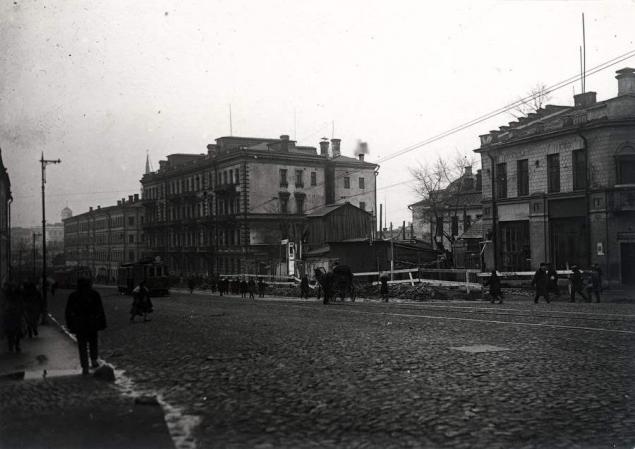
35. Dewatering?
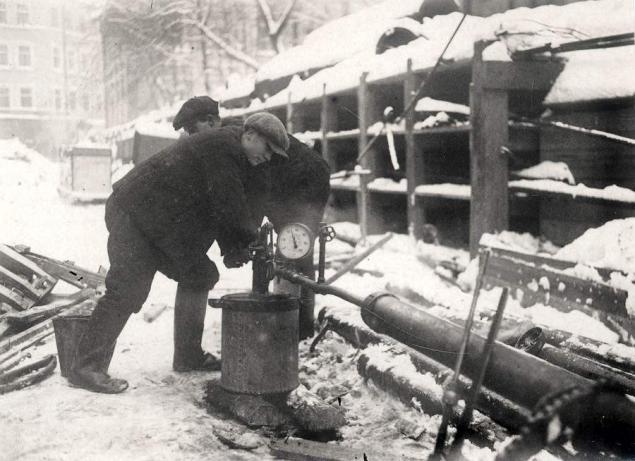
36. Some radiators.
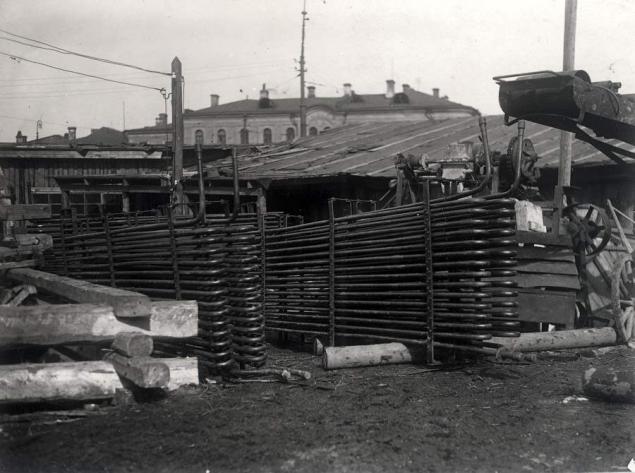
37.
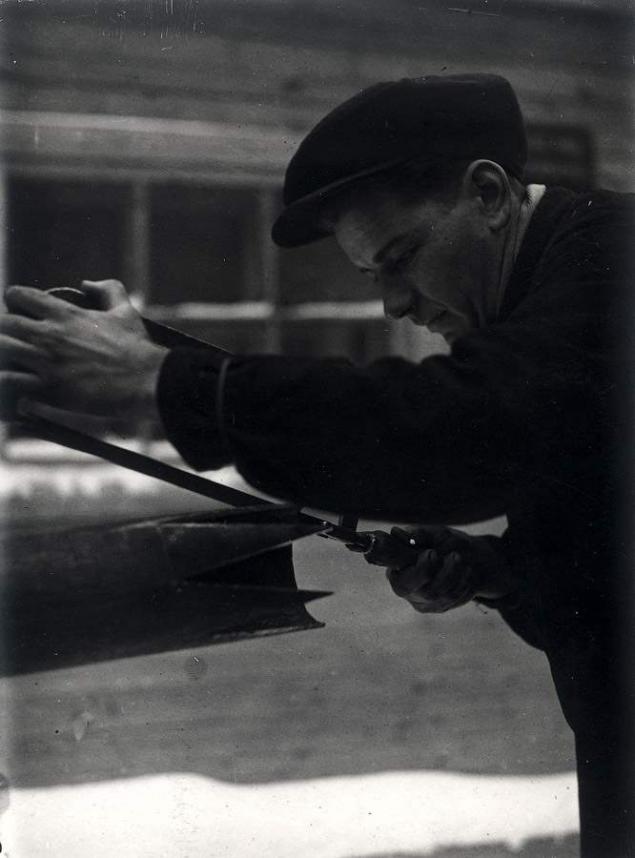
38. Shaft. Pay attention to the cracks in the concrete, marked by arrows.
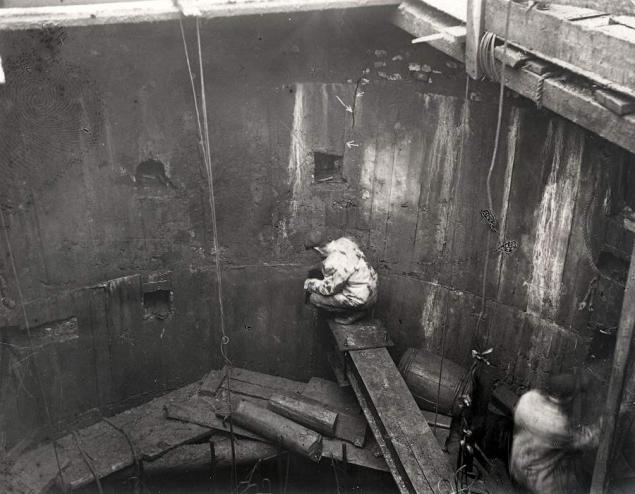
39. Apparently, this concreting jumper in the trunk between zones of high and normal pressure. Top tube sticking out of the box. The unit itself, where the compression and decompression, will be on top. Remember those big barrels photo №4?

40. The shooting led. Rather, they are squeezing rock pressure.
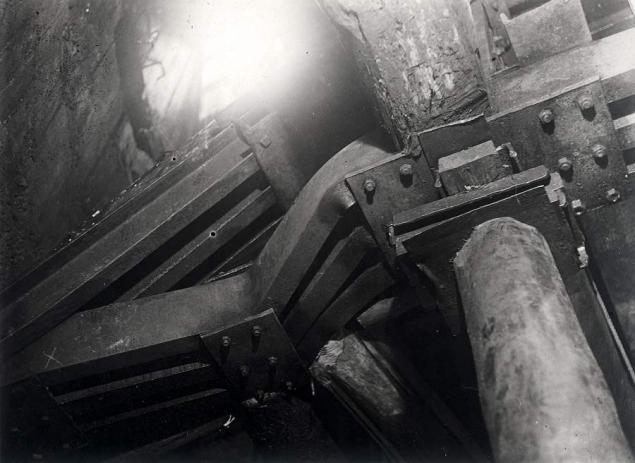
41. During the shooting a man stands. Pay attention to scale.
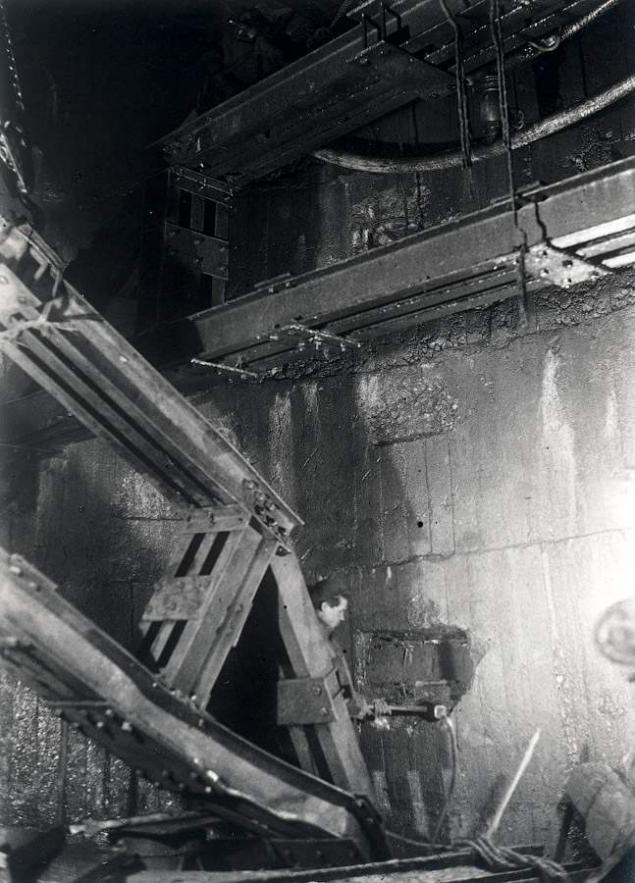
42
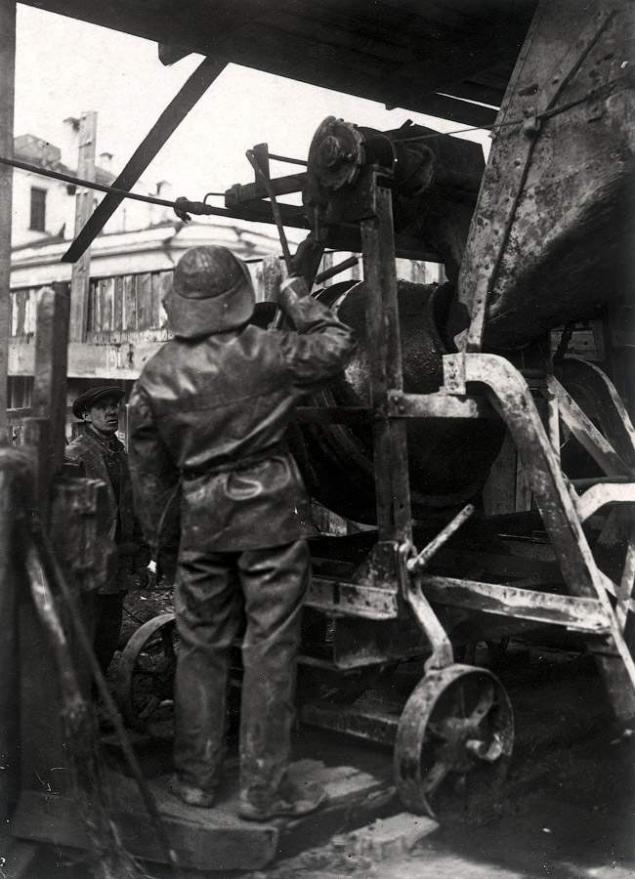
43. Ruddvor mine and issuing breed in Baida upstairs?
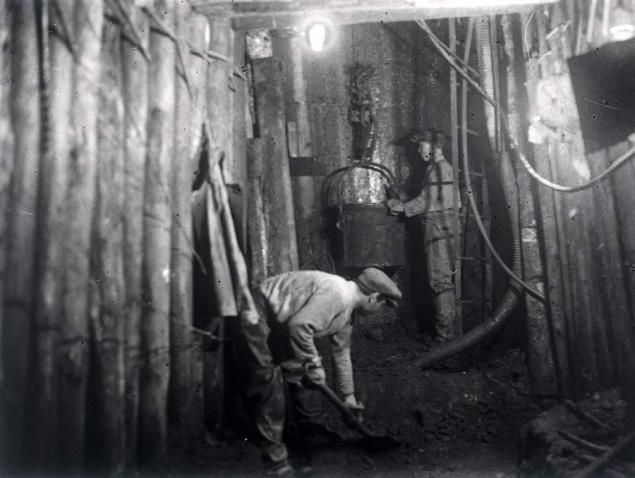
44.

45.
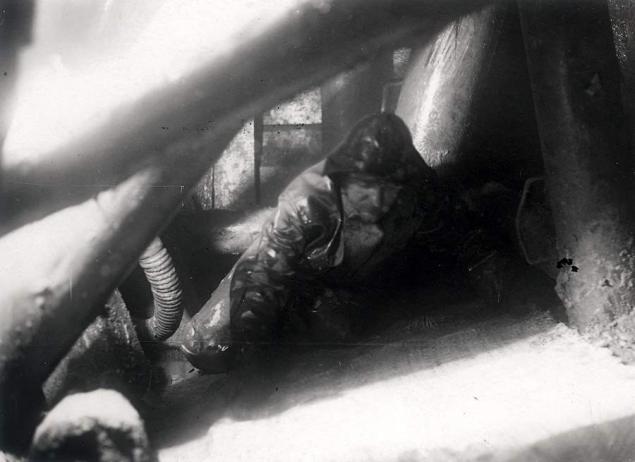
46.
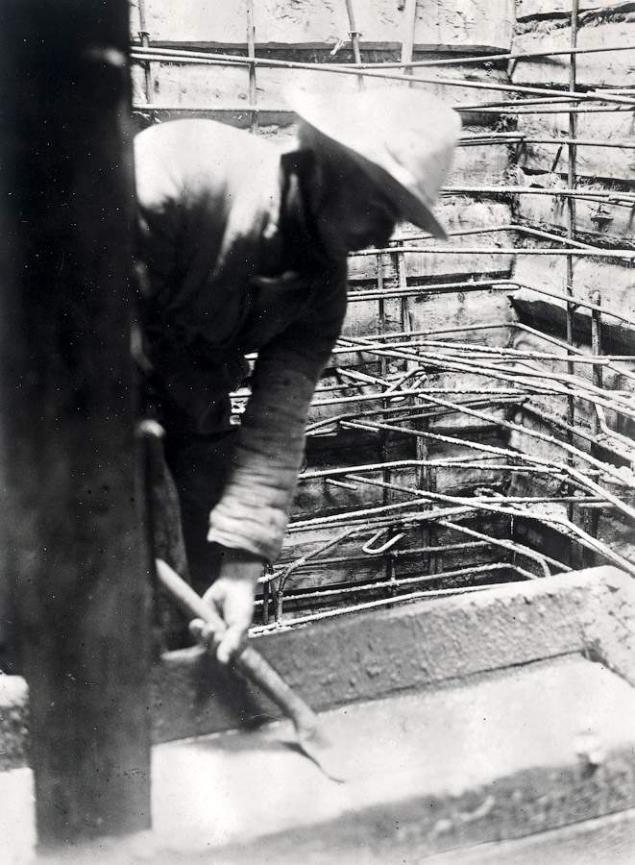
47.
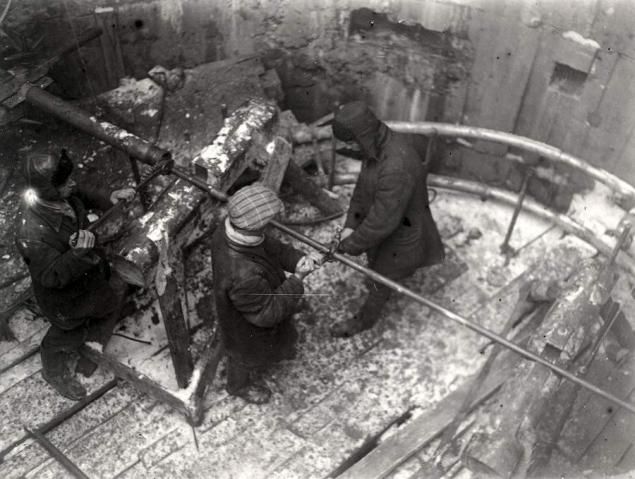
48. It seems orientated correctly.

49.
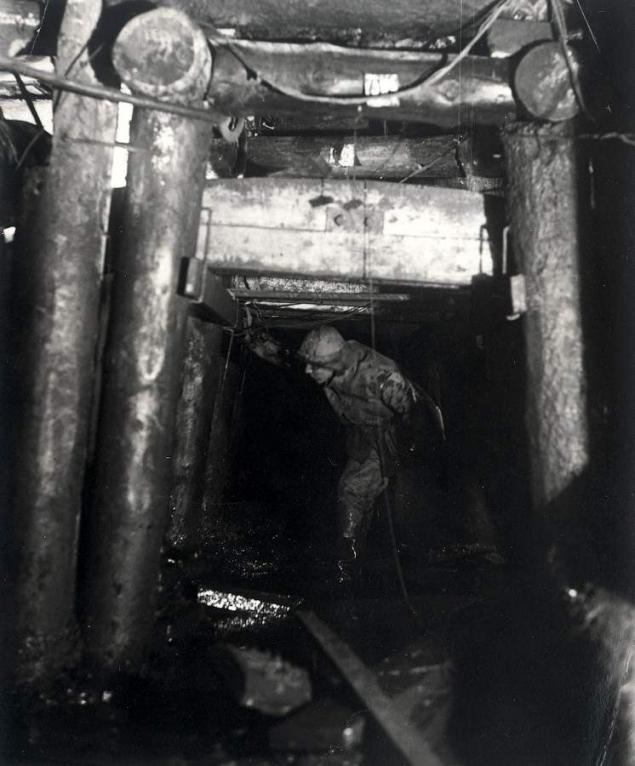
50.

51.
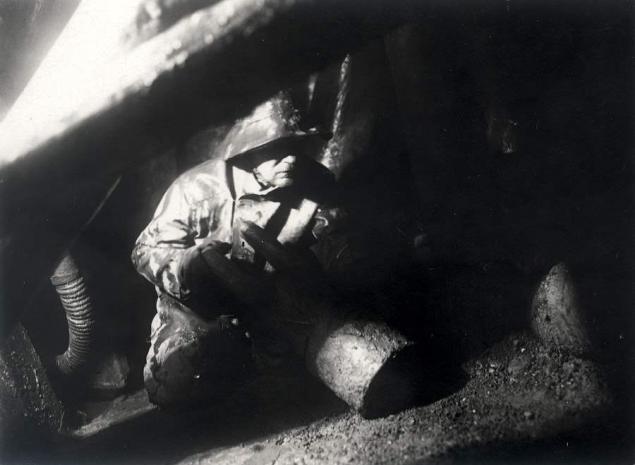
52.
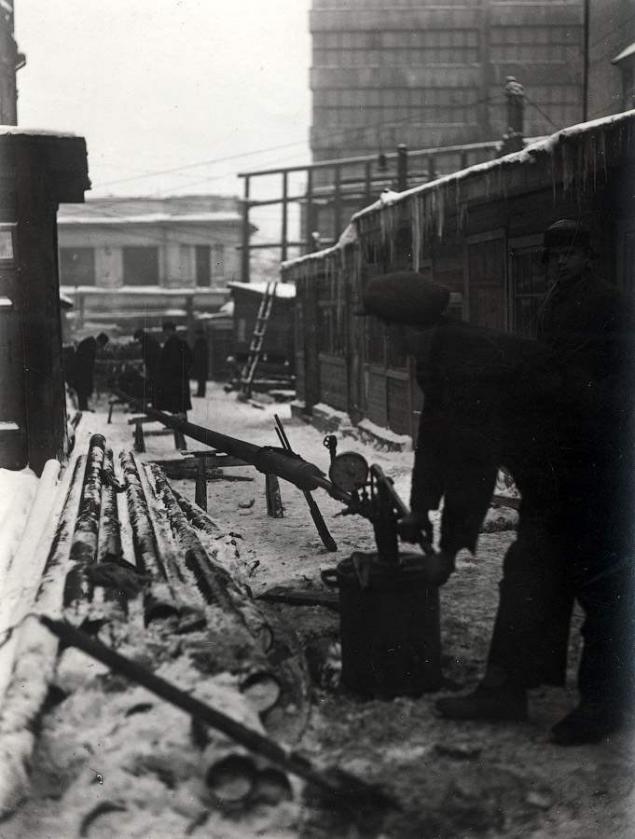
53.
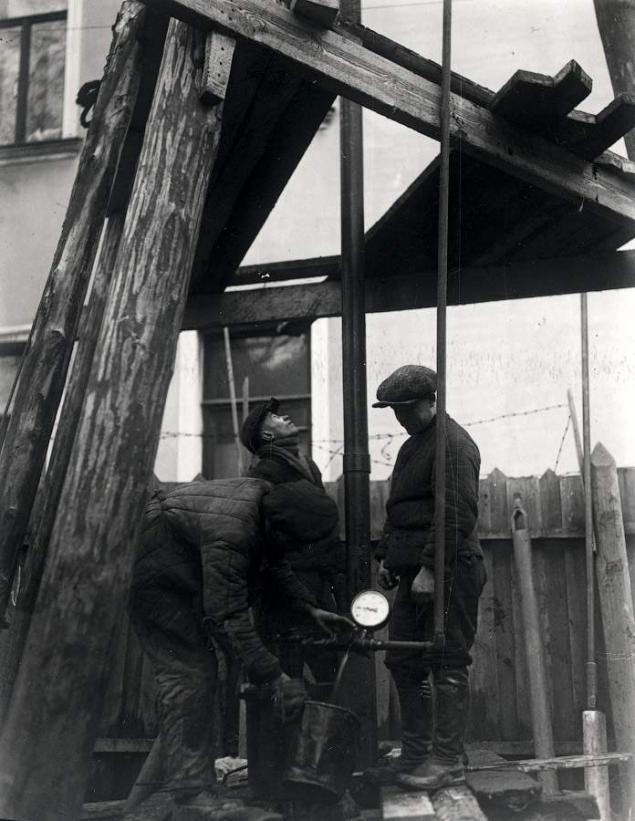
54.
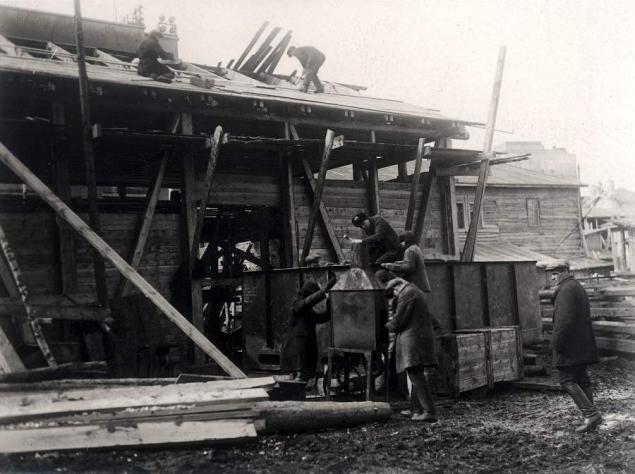
55. Install the radiator.
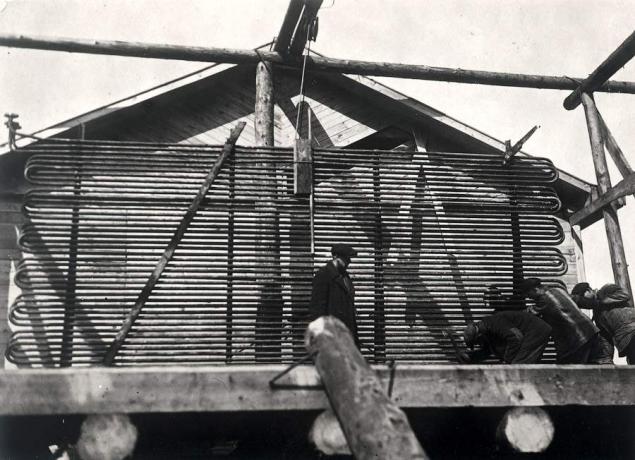
56. Lapping kuvaldometrom.
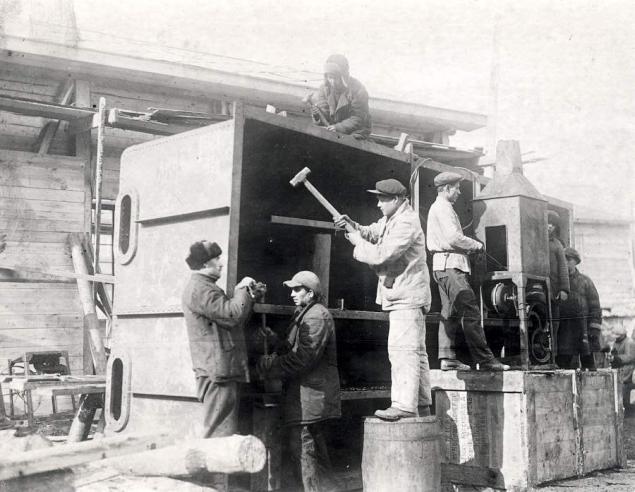
57. Radiator almost gathered. I do not know what it is. Can the system freeze at the mine №18 or part of any compressor station?
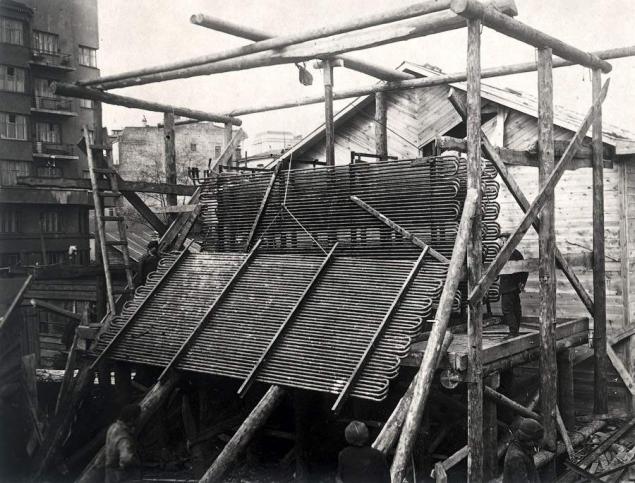
58.

59. The inscription on the back says that the photograph captures the installation of a ring 18 minutes of the mine. Most of all, we have in mind two ring circuit for freezing. By the way, look at the stairs: no insurance and rings behind.
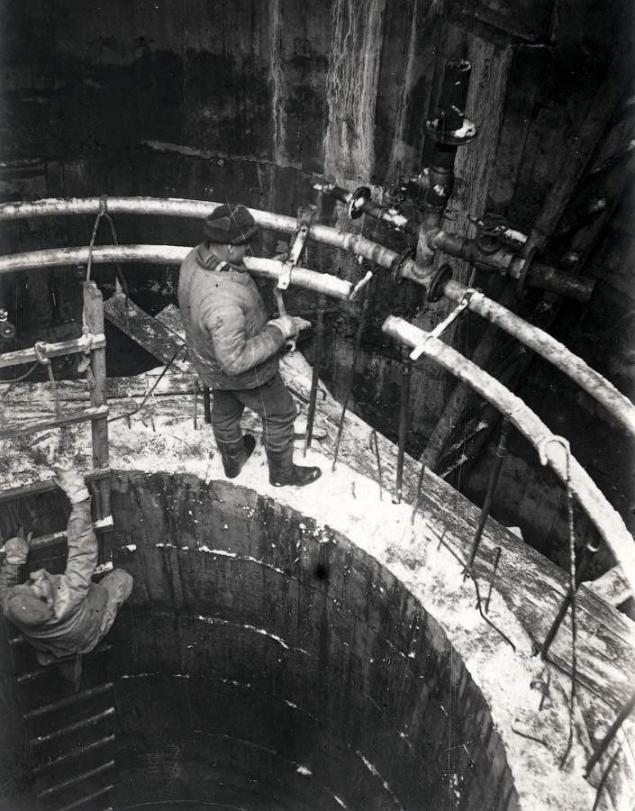
60. Turnover: Mine 20. Assembling metal dowel in the mine shaft.
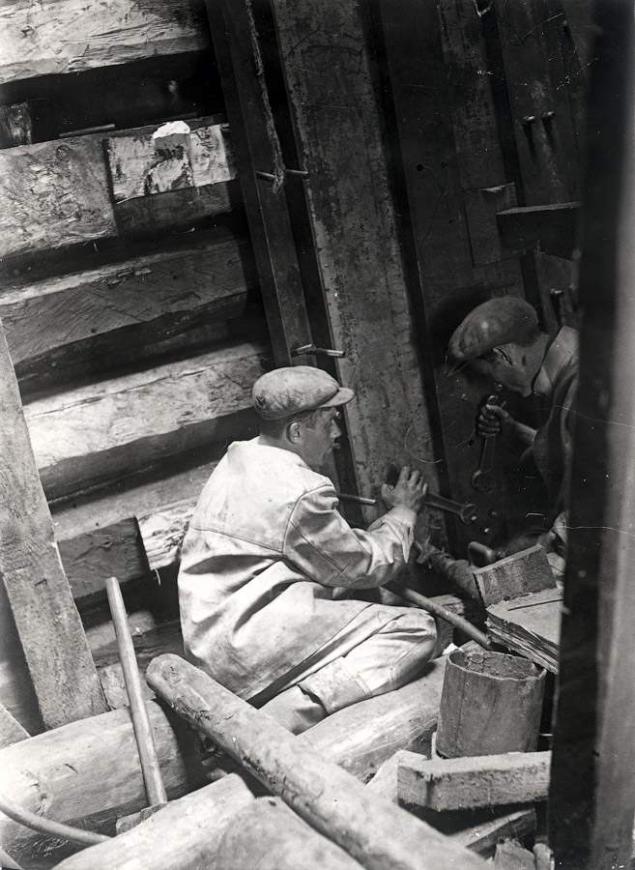
61. Turnover: Castle vault.

62.
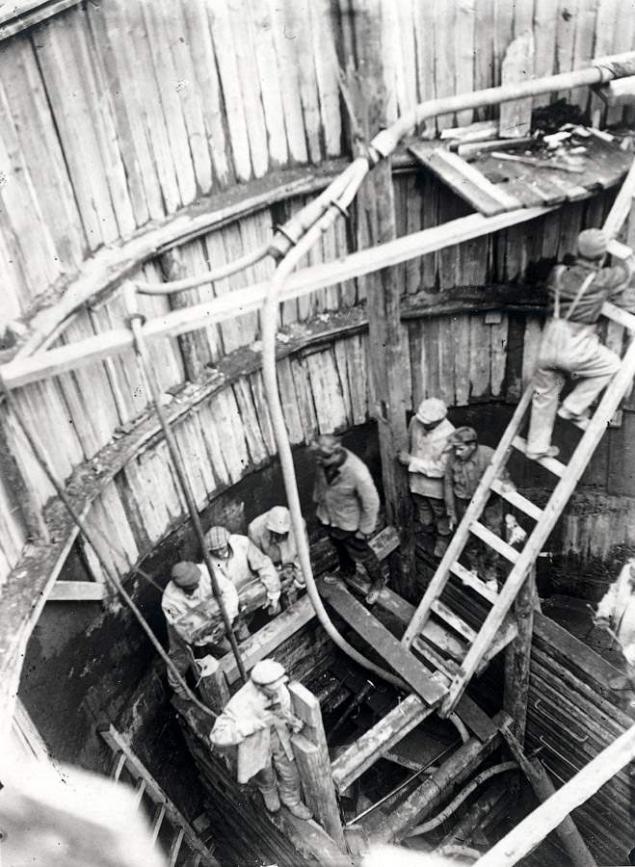
63. Turnover: Mine 18. Segments knife.
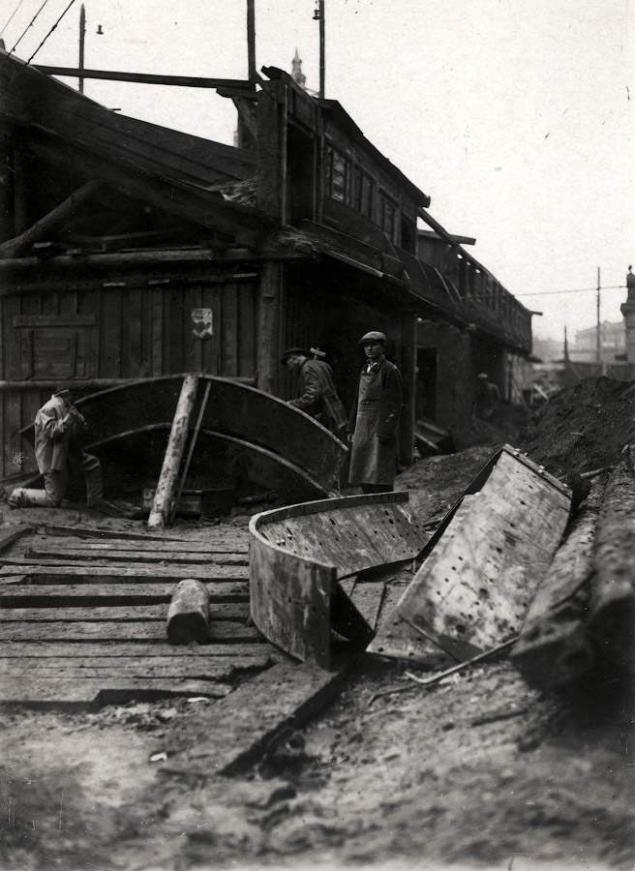
64. Turnover: Samples were taken out of the breed.
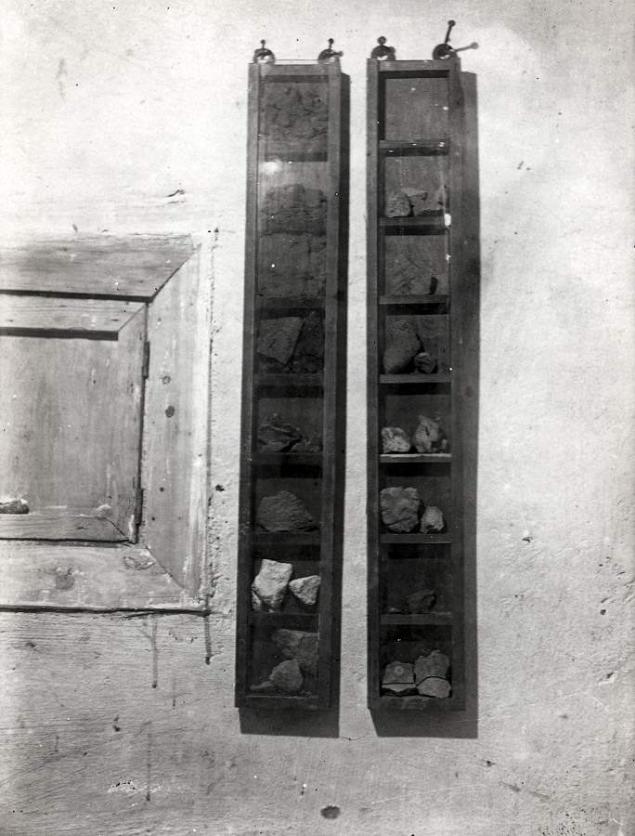
65. Signature on the back illegible, but it is clear that this winch cage lift. By the way, 80 years later Trolley feel the same as it was then - sticks stuck in the board.
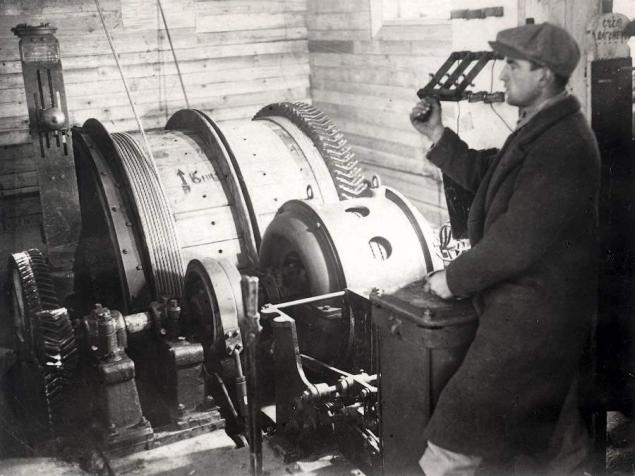
66. Turnover: Mine 18. Harvesting formwork and reinforcement collar circling front shaft.
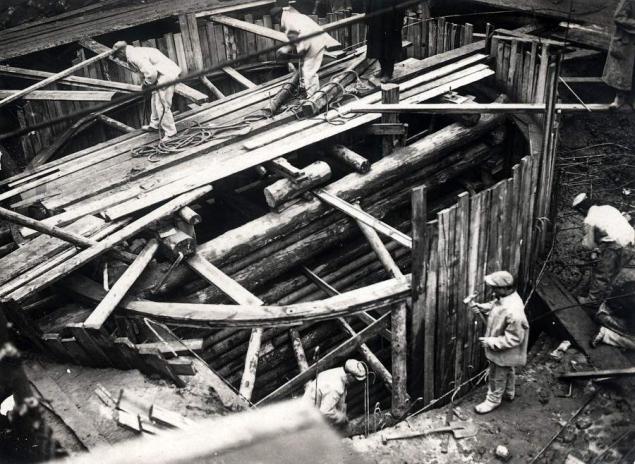
67. Turnover: Mine №18. Stripping front shaft.
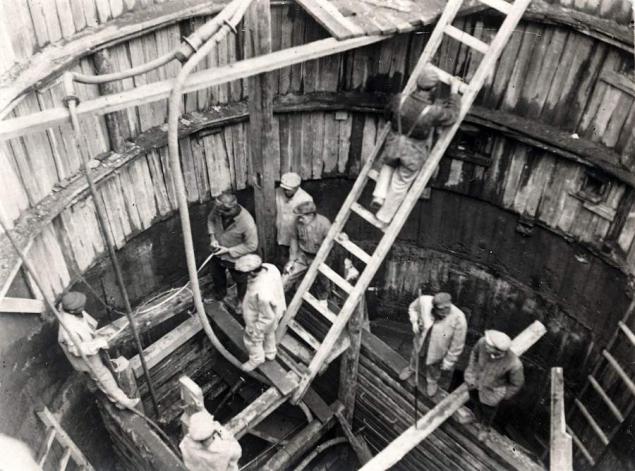
68.
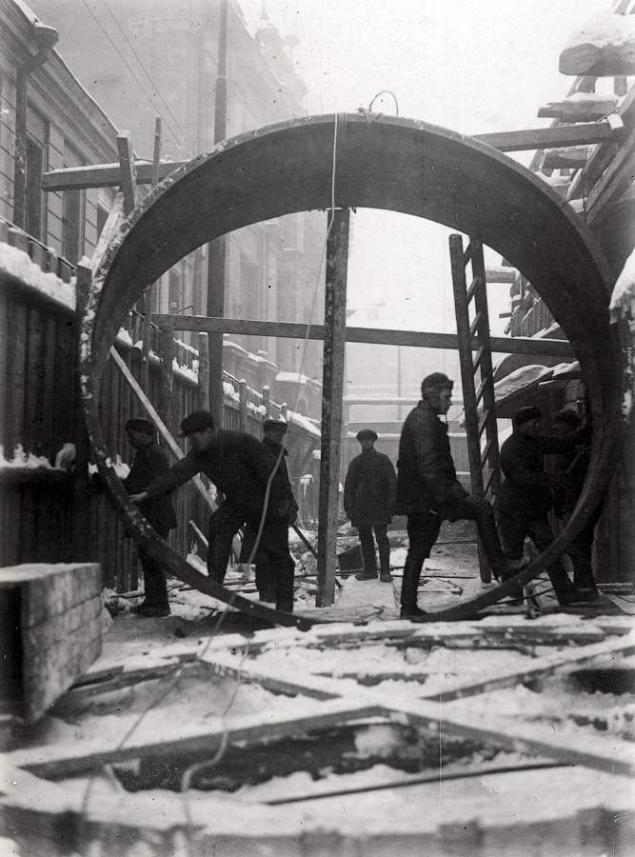
69.
Posted in [mergetime] 1301909331 [/ mergetime]
70. Turnover: Mine №18. Horizontal drilling.
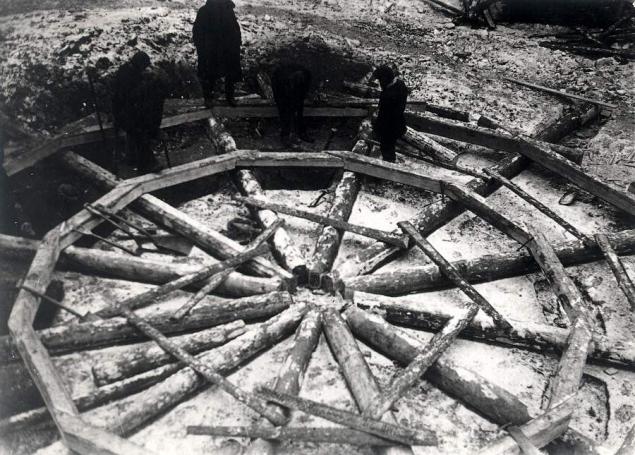
71.

72. Turnover: w. 23. Install the valve train. b. **** shell edge of the mine. Taken 29 IV '33

73. Turnover: Mine 18. Grapple in expanded form.
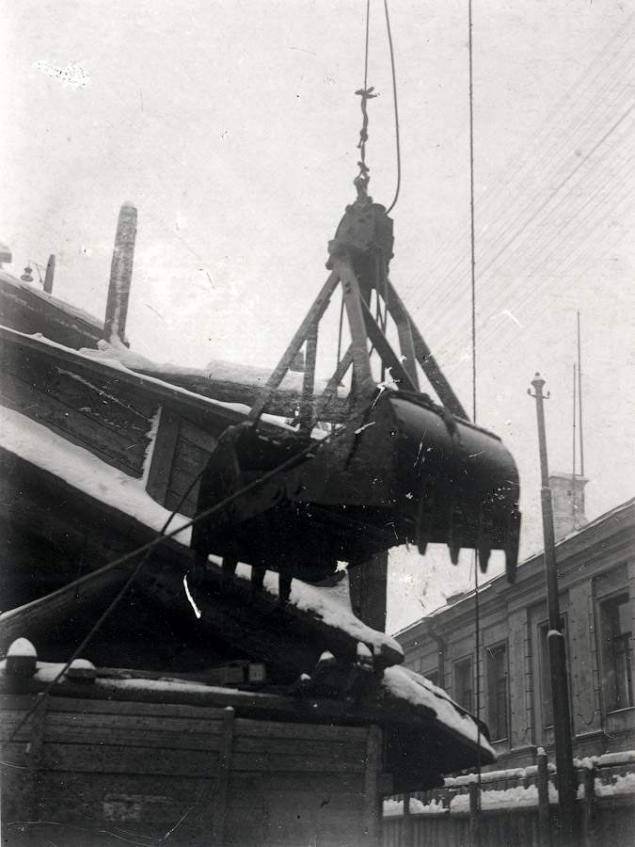
74. This picture was in the same pack, but it accurately depicts the construction of a second or later stage, as tunnels of iron tubing at the first stage is not.

Source:
A few years ago I came upon a bundle of old photographs from the newspaper "Metrostroevets." They were scanned and permanently buried on your hard drive. Now I'll show them to you. A dozen photographs signed on the back side. More on some you can guess what the object is in them or what people are doing metrostroevtsy. And some impossible to determine where the bottom, and where the top. But to each, I will try to give at least some comment.
To the question "Where was it taken?" You can answer clearly signed photo, a place where indicated.
Mine №18. (Station "Chistye Prudy", then - "Kirov»)
Tankelevich AG, Head of mine № 18-18-bis underground, at a depth of 40 meters, in the most difficult geological conditions should have been during the year to build a huge trehsvodchaty palace with large rooms, spacious lobby, wide corridors. For this construction had to apply new, hitherto unknown methods to go to master the unfamiliar equipment. We had to do a great job of digging, put tens of thousands of cubic meters of concrete. It was an honorable task and solve it was very interesting. The work was a lot.
74 photos
1. Flooded barrel. I can assume that it is mine №20 (- Comrades ... twentieth flooded mine ... no energy, pumps do not work. The water was coming fast. I walked 20 precast metal tongue, and the water went over it with great speed and force. Here), but in fact, we see flooded with outgoing trunk down the stairs.

Mine №20. (stage "Pure ponds" - "Red Gate") Noteworthy is the fact that has been passed by artificial freezing. It was a dress rehearsal before the sinking of the oblique stroke from freezing.
PP Rotert, head Metrostroi: Different methods of penetration of the inclined shafts. They could pass via compressed air. However, given that they are under the streets with more traffic, partly under the houses, we thought that the performance of work under compressed air in such circumstances required to have a full guarantee that there will be any interruption in the supply of electricity, as in this the case could be a major accident occur. Not wanting to go to risk, we decided to apply for the job method of freezing using directional wells. This method has previously been tested in the mine number 20, which we were specifically in such a way so as to prepare for the implementation of a more serious problem of sinking the inclined shafts.
2. Caisson devices. In the background is a building with a sign: "Barber №3. * - * Trust Sokolniki district. "

3. Ibid. In the foreground you can guess the shaft collar.

4. Yeah, it's mine. Workers are busy with a coffered device.

5. According to the couple, and a metal dowel, this Koper for its blockage.

6.

7.

8. Fossil.

9. What kind of exercise in the trunk. By today's standards of TB, of course, breath-taking - the workers lacked even a helmet. But for those times it was considered perfectly acceptable.

10. It seems, once again clogging the tongue. I recall that shaft sinking technology existed then a lot. Including, and avoiding the contour of the tongue, and dredging.

11. The trolley stands in the top of the pile driver. In the street, according to the icicles, cold.

12.

13.

14. In the bottom galleries.

15. Adit.

16. By kruzhalam in the foreground, is a preparation for concreting Calotte.

17.

18.

19. Details of the caisson.

20.

21. Old photoshop. Apparently, for the layout of the installation.

22. From a photo cut out right, superimposed on the white paper and make a copy again.

23. Caisson apparatus installed in the shaft.

24. Another fossil.

25. In the trunk. On the left - a large tank (most likely, compressed air), right - some pump. Maybe drainage.

26. Compressor. American. It says: «CHICAGO PNEUMATIC TOOL»

27. Lock vault. What is most interesting, it is made of stone instead of monolithic concrete.

28. The jack with the log.

29. Take out the breed?

30. It is not clear where is the upper hand, and what is this design. Some wedges are hammered into the metal tube.

31.

32. It seems that this is disclosed Calotte but not yet concreted.

33. Radiator?

34. Mine Street. Well, experts, identifies the street?

35. Dewatering?

36. Some radiators.

37.

38. Shaft. Pay attention to the cracks in the concrete, marked by arrows.

39. Apparently, this concreting jumper in the trunk between zones of high and normal pressure. Top tube sticking out of the box. The unit itself, where the compression and decompression, will be on top. Remember those big barrels photo №4?

40. The shooting led. Rather, they are squeezing rock pressure.

41. During the shooting a man stands. Pay attention to scale.

42

43. Ruddvor mine and issuing breed in Baida upstairs?

44.

45.

46.

47.

48. It seems orientated correctly.

49.

50.

51.

52.

53.

54.

55. Install the radiator.

56. Lapping kuvaldometrom.

57. Radiator almost gathered. I do not know what it is. Can the system freeze at the mine №18 or part of any compressor station?

58.

59. The inscription on the back says that the photograph captures the installation of a ring 18 minutes of the mine. Most of all, we have in mind two ring circuit for freezing. By the way, look at the stairs: no insurance and rings behind.

60. Turnover: Mine 20. Assembling metal dowel in the mine shaft.

61. Turnover: Castle vault.

62.

63. Turnover: Mine 18. Segments knife.

64. Turnover: Samples were taken out of the breed.

65. Signature on the back illegible, but it is clear that this winch cage lift. By the way, 80 years later Trolley feel the same as it was then - sticks stuck in the board.

66. Turnover: Mine 18. Harvesting formwork and reinforcement collar circling front shaft.

67. Turnover: Mine №18. Stripping front shaft.

68.

69.
Posted in [mergetime] 1301909331 [/ mergetime]
70. Turnover: Mine №18. Horizontal drilling.

71.

72. Turnover: w. 23. Install the valve train. b. **** shell edge of the mine. Taken 29 IV '33

73. Turnover: Mine 18. Grapple in expanded form.

74. This picture was in the same pack, but it accurately depicts the construction of a second or later stage, as tunnels of iron tubing at the first stage is not.

Source:
